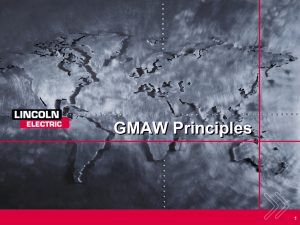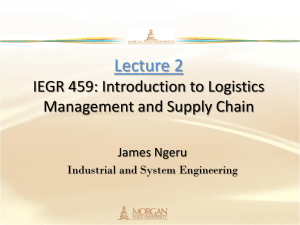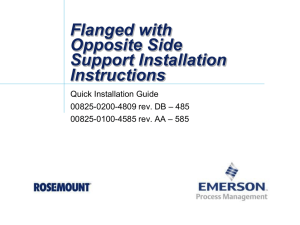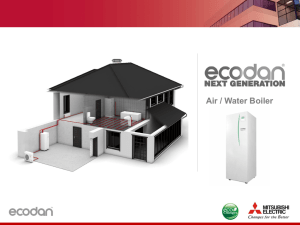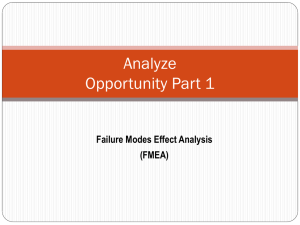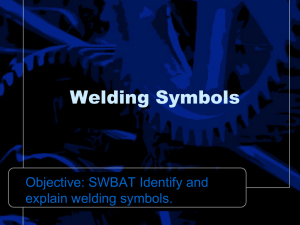คลิก
advertisement
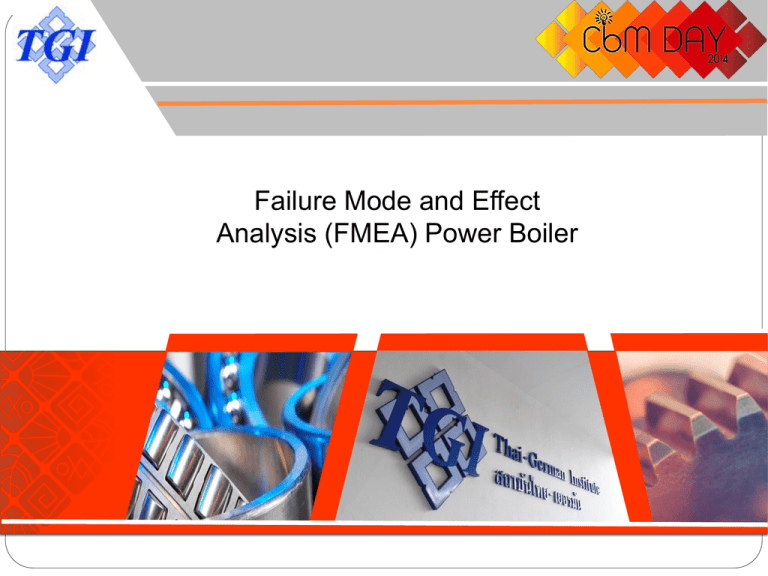
Failure Mode and Effect Analysis (FMEA) Power Boiler Agenda 1 2 3 Introduction to FMEA Introduction to Power Boiler Causes of failures in boiler system Case Study boiler pressure part Failure Mode and Effects Analysis (FMEA) 3 DEFINITION • Potential Failure Mode – สภาพหรื อรูปแบบความเสียหายของผลิตภัณฑ์ กระบวนการผลิต หรื อแม้ แต่การบริ การ ที่ยงั ไม่เกิดขึ ้น แต่คาดว่าจะเกิดขึ ้นได้ ในอนาคต • Potential Cause –สาเหตุที่เป็ นไปได้ ที่ก่อให้ เกิดสภาพหรื อรูปแบบความ เสียหายกับอุปกรณ์ • Effect – ผลลัพธ์ที่เกิดขึ ้นเนื่องจากความเสียหาย และส่งผลโดยตรงต่อ ผลิตภัณฑ์ กระบวนการผลิต และ การบริ การในที่สดุ • Analysis – การวิเคราะห์อย่างเป็ นระบบ ได้ แก่ การวิเคราะห์การออกแบบ กระบวนการ การทางานของผลิตภัณฑ์ และรวมไปถึงการวิเคราะห์ข้อมูลที่ เกี่ยวข้ องด้ วย 4 DEFINITION • Severity(SEV) – ค่าความรุนแรงของ Effect ในเชิงปริ มาณ • Current Control – การควบคุมหรื อการตรวจจับความเสียหายที่ดาเนินการอยู่ ในปั จจุบนั • Detection (DET) – ค่าความสามารถในการตรวจจับความเสียหายที่เกิดขึ ้นใน เชิงปริ มาณ • Recommended Action - วิธีการสาหรับป้องกันหรื อลดความเสี่ยงในการเกิด Potential Cause 5 DEFINITION • Risk Priority Number (RPN) – ค่าที่แสดงถึงความเสี่ยงของแต่ละ Potential Cause RPN = SEV x OCC x DET 6 FMEA PROCESS • ค้ นหาอุปกรณ์วิกฤต • รวบรวมข้ อมูลต่างๆของอุปกรณ์ เช่น หน้ าที่การทางาน ประวัติความเสียหาย ประวัติ การบารุงรักษา • วิเคราะห์หา Failure Mode ที่เป็ นไปได้ เช่น Leakage, Crack, Explosion, Deformation, Electrical Short เป็ นต้ น • วิเคราะห์หา Effect ของแต่ละ Failure Mode เช่น การบาดเจ็บ, หยุดการเดินเครื่ อง, ประสิทธิภาพลดลง เป็ นต้ น • กาหนด Severity (SEV) ของ Effect • วิเคราะห์หา Potential Cause ของแต่ละ Failure Mode 7 FMEA PROCESS • • • • • กาหนด Occurrence (OCC) ของแต่ละ Potential Cause ระบุ Current Control ของแต่ละ Potential Cause กาหนดค่าความสามารถในการ Detection (DET) คานวณหาค่า Risk Priority Number (RPN) ของแต่ละ Failure Mode หาวิธีการสาหรับป้องกันหรื อลดความเสี่ยงในการเกิด Failure Mode ที่มีคา่ RPN มากกว่า Criteria ที่กาหนด 8 FMEA PROCESS Equipment Function Occurence Potential Failure Modes Predictive Methods Potential Failure Effects Detection Severity RPN Potential Cause(s) Recommended Actions 9 FMEA PROCESS Component Potential Failure Mode Potential S O DR Potential Current Failure E C EP Causes Controls Effects V C TN Recommended Actions What is the What is How can Effect on the this be the Input? found? Outputs? How How How Often? bad? Well? What can go wrong with the What are the Input? Causes? What can be done? 10 SEVERITY Effect Severity of Effect Ranking Hazardous – Very high severity ranking – Affects operator, plant or W/O Warning maintenance personnel, safety and or affects noncompliance with government regulations, without warning. Hazardous – High severity ranking – Affects operator, plant or With Warning maintenance personnel, safety and/or affects noncompliance with government regulations with warning. Very High Downtime of more than 8 hours or the production of defective parts for more than 4 hours. High Downtime of between 4 and 8 hours or the production of defective parts for between 2 & 4 hours. Moderate Downtime of between 1 and 4 hours or the production of defective parts for between 1 and 2 hours. 10 9 8 7 6 11 SEVERITY Effect Severity of Effect Ranking Low Downtime of between 30 minutes and 1 hour or the production of defective parts for up to 1 hour. Very Low Downtime of between 10 and 30 minutes but no production of defective parts. Minor Downtime of up to 10 minutes but no production of defective parts Very Minor Process parameter variability not within specification limits. Adjustment or other process controls need to be taken during production. No downtime and no production of defective parts. None Process parameter variability within specification limits. Adjustment or other process controls can be taken or during normal maintenance 5 4 3 2 1 12 OCCURENCE Probability of Failure Failure Occurs every Hour Failure occurs every shift Failure occurs every day Failure occurs every week Failure occurs every month Criteria: No. of Criteria: The reliability based on failures within Ranking the users required time. Hrs of operation. 1 in 1 1 in 8 1 in 24 1 in 80 1 in 350 R(t) <1 %: MTBF is about 10% of the User’s required time. R(t) = 5%: MTBF is about 30% of User’s required time R(t) = 20%: MTBF is about 60% of the User’s required time. R(t) = 37%: MTBF is equal to the User’s required time. R(t) = 60%: MTBF is 2 times greater than the User’s required time. 10 9 8 7 6 13 OCCURENCE Probability of Failure Failure occurs every 3 months Failure occurs every 6 months Failure occurs every year Failure occurs every 2 years Failure occurs > 5 years Criteria: No. of Criteria: The reliability based on failures within Ranking the users required time. Hrs of operation. 1 in 1000 1 in 2500 1 in 5000 1 in 10,000 1 in 25,000 R(t) = 78%: MTBF is 4 times greater than the User’s required time. R(t) = 85%: MTBF is 6 times greater than the User’s required time R(t) = 90%: MTBF is 10 times greater than the User’s required time. R(t) = 95%: MTBF is 20 times greater than the User’s required time. R(t) = 98%: MTBF is 50 times greater than the User’s required time. 5 4 3 2 1 14 DETECTION Detection Very Low Low Medium High Very High Criteria Ranking Design or Machinery Controls cannot detect a potential cause and subsequent failure, or there are no design or machinery controls. Design or Machinery controls do not prevent the failure from occurring. Machinery controls will isolate the cause and subsequent failure mode after the failure has occurred. Design controls may detect a potential cause and subsequent failure mode. Machinery controls will provide an indicator of imminent failure. Design controls may detect a potential cause and subsequent failure mode. Machinery controls will prevent an imminent failure and isolate the cause. Design controls almost certainly detect a potential cause and subsequent failure mode, machinery controls not required. 10 7 5 3 1 15 RECOMMENDED ACTION คือ การกระทา หรื อ วิธีการใดๆ ที่ช่วยลดค่า Risk Priority Number ของ Potential Cause ซึง่ สามารถทาได้ โดยการลด Severity, Occurrence, Detection อย่างใดอย่าง หนึง่ หรื อ ทัง้ 3 อย่างพร้ อมกัน 16 Boiler pressure part Component Potential Failure Mode Potential Effect(s) of Potential Cause(s)/ Sev Occ Failure Mechanism(s) of Failure tube Preheater Fire side corrosion ECO. Evap/Wall FAC FAC Tube leak,gas side p. drop, low eff. tube leak tube leak Underdeposit Corrosion tube leak Short Term Overheat Graphitization High Temp. Corrosion tube burst Tube burst tube burst Long Term Overheat tube burst Type IV Crack Dissimilar Weld tube burst tube burst Pipe MSP RH Weld Defect Weld Defect, Type IV Crack pipe leak pipe leak Bypass Thermal Fatigue pipe leak Hdr ECO T Way Final SH FAC Crack dissimiilar weld leak leak SH/RH tube acid dew point 5 parameter model 5 parameter model high heat flux, low flow, high debris water low water flow mis mat'l, high temp. mat'L, corrosive media.,temp. low flow, inside oxide thk., high heat flux service condition, weld mat'l shaffer diagram. poor joint fitup & weld control poor joint fitup & weld control poor design, operation high cycle,mat'L suscept 5 parameter model Introduction to Power Boiler & Causes of failures in boiler system Combine Cycle Power Plant Thermal Power Plant 18 Hoz. flow Sub. Cri Pressure Ver. flow Sup. Cri Pressure Causes of failures in boiler system Corrosion -Water Side FAC Under deposit - Fire Side High Temp. Low temp. Erosion SCC Reference Nalco Guide Crack -Weld Defect Lack of Fusion Undercut Degradation - Graphitization - Creep Weld Creep -> IV Crack Base Metal Creep - Spherodisation Weld Defect DISCONTINUITY Excessive Convexity Insufficient Throat Undercut Insufficient Leg Size Poor Penetration Poor Fusion Overlap Porosity Slag Inclusions Cracks Excessive Spatter POSSIBLE CAUSES Slow travel speed that allows weld metal to build up Welding currents too low A combination of Travel speed to fast and current too high Improper placement of weld beads when multiple pass welding Amperage too high Arc length too long increasing the force of the arc so that it cuts into corners Improper weld technique causing the corners to be left unfilled or cut into Groove joint not completely filled and overlapped Using the wrong electrode angle causing the weld to be deposited to heavily on one side Using the wrong angle on multiple pas welds Causing the welds to overlap incorrectly Amperage too low Travel speeds too fast Using too large an electrode for the root of the joint Improper electrode angle at the root of the joint Improper weave technique Using the wrong electrode for the desired joint penetration: (using E-6013 instead of E-6010) Amperage too low Travel speeds too fast Improper electrode angle at the sides of the joint Improper weave technique that does not allow enough time at the sides of the joint Using the wrong electrode for the application Amperage too low and /or travel speed too slow Electrode too large with low currents Dirty base metal painted or galvanized surfaces Arc length too long especially with E-7018 Electrodes Moisture in low hydrogen electrodes Wind or fans strong enough to break down the shielding gas Improper manipulation of the electrode especially with E-6013 Improper cleaning and slag removal between multiple pass welds Using the wrong Electrode for the application Using Excessively high amperage on some metals Amperage too high Electrode angle too extreme Arc length too long Boiler tube Failure Case Study boiler pressure part FAC Thermal Fatigue Erosion Graphitization Conclusions
